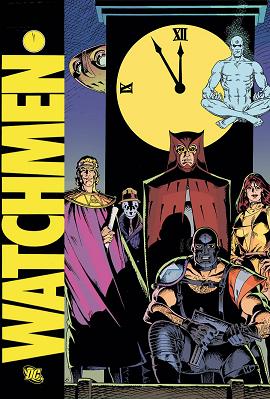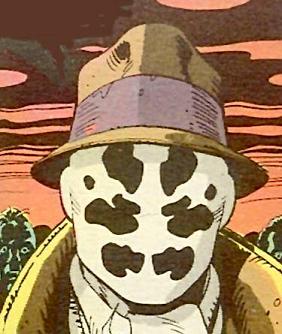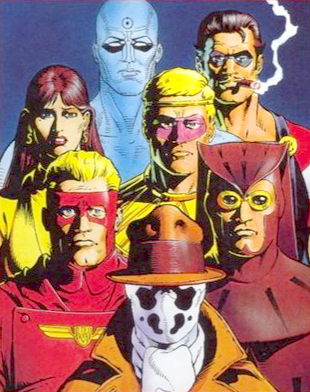Comic Book Confidential: Watchmen
 Comic books were the medium that taught me to read or at least inspired me to with a desire to know what the Justice League characters were saying as they fought supervillians and monsters. I gradually lost interest in them around the late 70’s but I still revisited my collection from time to time. In college, I was reintroduced to comic books by more astute readers than myself and was immediately impressed by the adult nature they had been infused with during the past decade. Chief among those tales that rekindled my interest, which still continues to this day, was Alan Moore’s Watchmen. I recall, twenty years ago, debating what an incredible film this story would make if it were done properly. After many false starts and a late in the game lawsuit, the motion picture adaptation finally opens this Friday in theaters everywhere. This seems like an appropriate time for a brief, spoiler free, refresher for those familiar with the work and a preview of what is to come for everyone else.
Comic books were the medium that taught me to read or at least inspired me to with a desire to know what the Justice League characters were saying as they fought supervillians and monsters. I gradually lost interest in them around the late 70’s but I still revisited my collection from time to time. In college, I was reintroduced to comic books by more astute readers than myself and was immediately impressed by the adult nature they had been infused with during the past decade. Chief among those tales that rekindled my interest, which still continues to this day, was Alan Moore’s Watchmen. I recall, twenty years ago, debating what an incredible film this story would make if it were done properly. After many false starts and a late in the game lawsuit, the motion picture adaptation finally opens this Friday in theaters everywhere. This seems like an appropriate time for a brief, spoiler free, refresher for those familiar with the work and a preview of what is to come for everyone else.
Dog carcass in alley this morning, tire tread on burst stomach. This city is afraid of me. I have seen its true face. The streets are extended gutters and the gutters are full of blood and when the drains finally scab over all the vermin will drown. The accumulated filth of all their sex and murder will foam up about their waists and all the whores and politicians will look up and shout “save us!”…..and I’ll look down and whisper “no.”
– Rorschach’s Journal, October 12th, 1985.
This was the first passage from the first issue of Watchman. Alan Moore made it clear from the beginning that this was not your typical comic book and readers were in for the ride of their lives. Along with Frank Miller’s The Dark Knight, Watchmen was the first of what would come to be known as graphic novels, the term comic book no longer applied. These were dark and serious tales with intricate plots and stories within stories. The way people looked at comic books was about to be changed forever, all thanks to one twelve issue series.
 In 1985, Alan Moore pitched an idea to DC Comics to do a miniseries featuring the superhero characters they had recently acquired when they bought Charlton Comics. The story would begin with the murder of a paramilitary character, Peacemaker (The Comedian), and then center around the resulting investigation conducted by The Question (Rorschach). It would also feature Captain Atom (Dr. Manhattan), Nightshade (Silk Spectre), Blue Beetle (Nite Owl), and Peter Cannon, Thunderbolt (Ozymandias). This would be a very dark story of an alternate world where the public’s distrust of masked heroes has forced them into exile and now someone appears to be intent on killing them off.
In 1985, Alan Moore pitched an idea to DC Comics to do a miniseries featuring the superhero characters they had recently acquired when they bought Charlton Comics. The story would begin with the murder of a paramilitary character, Peacemaker (The Comedian), and then center around the resulting investigation conducted by The Question (Rorschach). It would also feature Captain Atom (Dr. Manhattan), Nightshade (Silk Spectre), Blue Beetle (Nite Owl), and Peter Cannon, Thunderbolt (Ozymandias). This would be a very dark story of an alternate world where the public’s distrust of masked heroes has forced them into exile and now someone appears to be intent on killing them off.
DC liked the concept but was already committed to integrating the Charlton characters into the rest of their universe with the upcoming Crisis on Infinite Earths series. This would also eliminate the use of a multiple Earth, so DC insisted on new characters and settings that had no continuity with any existing properties. While it would have been interesting to see Moore’s take on established characters, this move was a wise one in the long run and gave him considerably more freedom to create an alternate reality that was similar to but also significantly different from our own because of the existence of these heroes.
In the world of the Watchmen, masked heroes and costumed adventurers first appeared in the 1940’s. These heroes were normal people with only slightly above average skills and an honest desire to fight crime and make the world a better place. They banded together as a loose knit group called the Minutemen and kept the peace for many years. It wasn’t until the 1950’s, when an accident during an experiment on deconstructing matter changed a scientist into the near omnipotent Dr. Manhattan, that a true superhero arrived.
Dr. Manhattan’s creation triggered the beginning of the real divergence of this reality. As a result of his intervention, the United States won the Vietnam War and, as of 1985 when this story takes place, Richard Nixon is still the president. There are escalating hostilities throughout the rest of the world but America is largely immune due to Dr. Manhattan’s presence. After a new group composed of original and second generation crime fighters fails in the conception stages, public opinion on masked heroes begins to sour. By the late 1970’s, they are branded vigilantes and are either forced into retirement or put on the government payroll. The one exception to this is a man in an ever shifting blotched mask who calls himself Rorschach.
 Rorschach appears on the surface the most simplistic of heroes, not much more than an amateur detective in a trench coat and fedora with a cool mask. His “super power” is his innate hatred of evil that has been pushed to a psychotic level as a result of his career as a crime fighter. As his former partner Nite Owl states, “…look at Rorschach, the condition he’s in. He was normal once. Sure, he was quiet, he was grim, but he still had all the buttons on his overcoat. What I’m saying is he was rational then. Over the years, that mask’s eaten his brains.”
Rorschach appears on the surface the most simplistic of heroes, not much more than an amateur detective in a trench coat and fedora with a cool mask. His “super power” is his innate hatred of evil that has been pushed to a psychotic level as a result of his career as a crime fighter. As his former partner Nite Owl states, “…look at Rorschach, the condition he’s in. He was normal once. Sure, he was quiet, he was grim, but he still had all the buttons on his overcoat. What I’m saying is he was rational then. Over the years, that mask’s eaten his brains.”
Beginning life at the poverty level as the unwanted child of single mother, Walter Kovacs spent his early years in reform school before being cast out into the world. He survived as a menial laborer in the garment industry until the day he discovered the inky fluid filled material that he would use to create his mask. At first, the disguise was an outlet to allow him an escape from his mundane life but it quickly began to take over. Eventually Rorschach became the dominant personality and Kovacs was nothing more than the secret identity that hid him from the world. When a congressional act was passed to outlaw the masked heroes, Rorschach made his stance clear. He left the corpse of a serial rapist outside police headquarters with note containing one word – “NEVER”.
Now eight year later, the death of The Comedian, a member of the Minute Men who had gone to work for the government rather than retire, puts Rorschach on a case that goes far deeper than anyone can imagine. While attempting to protect his allies from what he believes to be a mask killer, Rorschach’s tenacious sanity is pushed beyond its limits. On the way to the story’s shocking conclusion, heroes will rise and fall and the world will be irrevocably changed.
 Watchmen was the comic book that introduced many readers to the style of Alan Moore. While a linear plotline serves as the core of the tale, it is peppered throughout with allusions, both written and drawn. Multiple pages are dedicated to a seemingly unrelated story about the grueling trails of a shipwrecked sailor. As this tale unfolds, its words begin to “bleed” into the main panels and underscore their content. Every issue features supplemental material at the end that helps to further flesh out the events in the main story. These were trademarks that Moore would carry with him to almost every future project.
Watchmen was the comic book that introduced many readers to the style of Alan Moore. While a linear plotline serves as the core of the tale, it is peppered throughout with allusions, both written and drawn. Multiple pages are dedicated to a seemingly unrelated story about the grueling trails of a shipwrecked sailor. As this tale unfolds, its words begin to “bleed” into the main panels and underscore their content. Every issue features supplemental material at the end that helps to further flesh out the events in the main story. These were trademarks that Moore would carry with him to almost every future project.
One of the most unique facets of this story is its finality. In spite of its immense popularity, Watchmen has remained contained in the original twelve issues. There has never been a sequel or prequel to taint the original tale. The feature film opening March 6 will be its first interpretation in a different medium. It will be interesting to see how this bleak tale of the twilight of the superheroes translates to the big screen and is received by the general public. Who will watch the Watchmen?
This last entry. Will shortly mail journal to only people can trust. In reading this now, whether I am alive or dead, you will know the truth. For my own part, regret nothing. Have lived life free from compromise and step down into the shadows now without complaint.
– Rorschach’s Journal, November 1st, 1985
Watchman Movie Update
Thanks to the kind people at Sun Coast Comics in Jacksonville, I was able to see an advanced screening of the film. It does a very good job of keeping the flavor of the original story and most of the good scenes from the comics make it to the screen. Even with its near three hour running time, some elements had to be abridged, condensed or eliminated. There are some revisions to the plot that are done as a concession to the time limitations of the film. The casting is surprisingly good and the soundtrack is put to excellent use. While comic book purists may find that story would have been better served as a television miniseries, this film is still a Fanboy must see. It contains graphic violence and nudity so it is definitely not for children.
